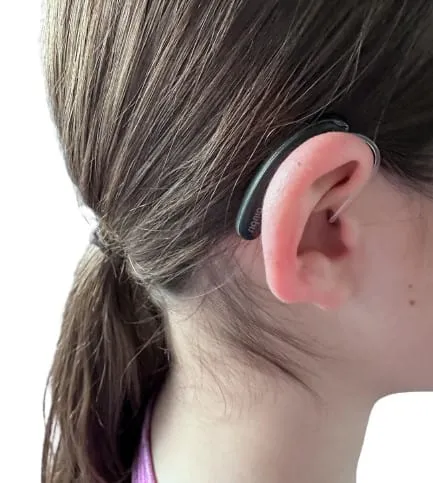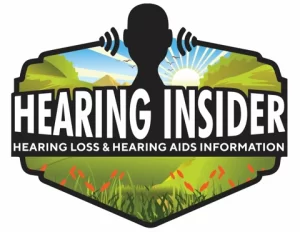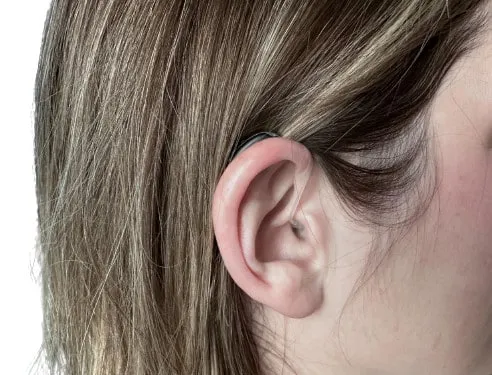If you have long hair, you know that finding the right hairstyle, accessories, and products can be a challenge. But have you ever considered how your hair could impact your hearing aid? For people with hearing loss, choosing the right device is crucial for improving communication and quality of life. However, selecting a hearing aid that works well with long hair can pose its own set of difficulties.
Hearing aids come in different shapes, sizes, and styles, and finding the right fit can be a complex process. For people with long hair, the device must be compatible with the length, texture, and style of their hair to ensure comfort and effectiveness. A hearing aid that constantly tangles or falls off can be frustrating and even lead to decreased use or the hearing aid ending up in your bedroom drawer.
This is where the expertise of an audiologist comes into play. Audiologists are trained professionals who specialize in evaluating hearing loss and recommending the best device for each patient’s unique needs. I have personally fitted hearing aids on thousands of people working in the VA health care system. However, most of my patients are male with generally shorter hair but I do encounter long hair on patients from time to time.
In this article, we will explore the challenges of finding the right hearing aid for people with long hair from my own experience, the importance of selecting a device that fits well and is comfortable to wear, and the crucial role of your own personal audiologist in helping you make informed decisions.
Factors To Consider When Selecting Hearing Aid
When selecting a hearing aid, people with long hair need to consider several factors that could impact the fit, comfort, and effectiveness of the device. Here are some key factors to keep in mind:
- Hair length and thickness: Long hair can get tangled in the BTE/RIC hearing aid, leading to discomfort and reduced effectiveness. People with long hair should opt for devices that are smaller and sleeker to minimize interference or may want to consider devices that only go inside their ears.
- Hair texture and style: Hair texture and style can also impact the fit of a hearing aid. Curly or wavy hair may require a more customized solution, such as a device with a flexible wire that conforms to the shape of the ear with a custom earmold that does not get pulled out easily.
- Ear placement and size: The size and shape of the ear can impact the fit and effectiveness of a hearing aid. An audiologist can help determine the optimal placement and size of the device for each patient. A behind-the-ear device should sit at the very top of the pinna (external ear). If the wire is too long it will come off easier.
- Type of hearing loss and hearing aid technology: The type and severity of hearing loss can impact the type of hearing aid technology that is most appropriate. An audiologist can help patients understand their options and choose a device that best meets their needs.
- Personal preferences and lifestyle: Hearing aids come with different features, such as Bluetooth connectivity, noise reduction, and directional microphones. People with long hair should consider their personal preferences and lifestyle when choosing a device, such as whether they frequently engage in activities that require the use of headphones or headwear.
The biggest benefit of long hair with hearing aids is that your hearing aids will not be noticable. That is a big benefit for many people who are cosmetically driven.

By considering these factors, people with long hair can select a hearing aid that not only works effectively but also fits comfortably and complements their lifestyle. An audiologist can provide personalized recommendations based on individual needs and preferences, making the process of selecting a hearing aid as smooth as possible.
Recommendations for People with Long Hair
There are several recommendations that can help make the process of using hearing aid smoother and more successful. Here are some tips for people with long hair when choosing and using a hearing aid:
- Opt for smaller, sleeker devices that won’t get tangled in hair: As mentioned earlier, selecting a device that is smaller and sleeker can help minimize interference from long hair. I would still recommend a RIC style of hearing aid for most people but if it doesn’t work hair consider an ITE or invisible device. Your audiologist can inform you about what would be best for your specific hearing loss.
- Consider remote microphones or Bluetooth streaming devices to reduce interference from hair: Remote microphones and Bluetooth streaming devices can help minimize the effects of hair contact with the hearing aid and with hearing scratching noises. These accessories can be particularly useful in situations where interference from hair is more likely, such as when wearing headphones or participating in sports.
- Use styling products or accessories to manage hair and prevent contact with the hearing aids: Styling products such as hairspray or gel can help keep hair in place and prevent contact with the hearing aids. Headbands or clips can also be used to hold hair away from the device.
By following these recommendations, people with long hair can choose a hearing aid that not only works effectively but is also comfortable and minimizes interference from hair. It’s important to consult with an audiologist to determine the best device and management techniques for each individual’s unique needs. As always check out my guide on my favorite hearing aids.
Wearing Hearing Aids with Wet Hair
Whether you’ve just stepped out of the shower or been caught in a sudden downpour, it’s not uncommon to wonder about the implications of having wet hair in close proximity to your hearing aids. While it’s always recommended to avoid exposing hearing aids to unnecessary moisture, the specific impact of having wet hair next to your hearing aids depends largely on the quality and specifications of your devices.
Today, most professionally fit hearing aids come with an ingress protection (IP) rating of IP67 or IP68 or beyond IP68. This rating signifies the device’s ability to resist dust and moisture ingress, with the second number (7 or 8) indicating the level of water resistance. An IP67-rated device can typically withstand accidental immersion in up to 1 meter of water for up to 30 minutes, while an IP68-rated device can endure prolonged submersion in deeper water. Thus, with such a rating, your hearing aid should generally be safe to wear even if your hair is wet.
However, if you’re using a less expensive or older model without a robust IP rating, you may encounter some issues. These devices are not as water-resistant and the moisture from your wet hair could potentially seep into the hearing aid. This may lead to a buildup of moisture within the device, causing it to stop working temporarily.
If you find yourself in such a situation, don’t panic. The first step is to remove your hearing aid and dry it out thoroughly. Depending on the extent of moisture buildup, this process could take anywhere from a few hours to a day. In many cases, once the hearing aid is completely dry, it should return to normal operation.

